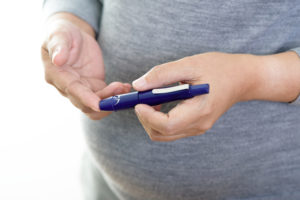It is possible to develop diabetes while you are pregnant. While pregnant, women become somewhat resistant to insulin. Most women will compensate by producing more insulin. Some women do not, and as a result their blood sugar can rise. This occurs in about 7% of pregnant women. Having gestational diabetes is associated with some problems and complications in pregnancy, and is associated with a higher risk of developing type 2 diabetes outside of pregnancy.
 Some complications associated with having gestational diabetes include having a large baby (called macrosomia). If your baby is larger, this can increase the risk of the shoulder getting stuck at delivery (called shoulder dystocia) or needing to have a c-section because the baby will not fit through the pelvis. Stillbirths, while rare, are more common in women whose blood sugar is not well controlled. Pre-eclampsia, a complication involving high blood pressure and organ dysfunction, is more common in women with gestational diabetes, and can necessitate urgent delivery of your baby. After delivery, a baby of a mother with gestational diabetes may have problems with their own blood sugar levels for a period of time.
Some complications associated with having gestational diabetes include having a large baby (called macrosomia). If your baby is larger, this can increase the risk of the shoulder getting stuck at delivery (called shoulder dystocia) or needing to have a c-section because the baby will not fit through the pelvis. Stillbirths, while rare, are more common in women whose blood sugar is not well controlled. Pre-eclampsia, a complication involving high blood pressure and organ dysfunction, is more common in women with gestational diabetes, and can necessitate urgent delivery of your baby. After delivery, a baby of a mother with gestational diabetes may have problems with their own blood sugar levels for a period of time.
Screening is offered for gestational diabetes between 24 and 28 weeks of pregnancy. It may be offered earlier if you have risk factors such as gestational diabetes in a previous pregnancy, if you are overweight, or if we notice sugar on your urine dip. The screening test involves drinking a sugary orange drink and having your blood sugar level tested one hour afterwards. Three results are possible:
1.You do not have gestational diabetes
2.Your screen is borderline for gestational diabetes
3.Your screen indicates that you do have gestational diabetes
If your screen is borderline for gestational diabetes, then we suggest a more involved 2 hour test where your blood sugar is measured fasting, and again 1 hour and 2 hours after drinking a sugary drink.
If you are diagnosed with gestational diabetes either on the 1 hour or the 2 hour test, then you will be referred to a specialist in diabetes who will help you to learn how to monitor your blood sugars and discuss dietary changes that can help improve your blood sugars. For most women, this is all that is needed. If dietary changes do not help and your blood sugars continue to be high, then insulin may need to be started. Keeping your blood sugar well-controlled can reduce the risk of having a large baby, and can reduce the risk of the baby having trouble with blood sugar levels after delivery.
There is mixed evidence regarding the effectiveness of controlling blood sugar on outcomes such as c-section rates and pre-eclampsia. Because some studies have not shown much of an effect on these outcomes, some women may choose not to be screened for gestational diabetes.
There is also mixed evidence on the benefits of induction of labour at term in preventing complications such as stillbirth, shoulder dystocia, and c-section. This might be something that is discussed if your baby is measuring very large, or if your blood sugars are not well controlled. In these circumstances, if your cervix is ready for labour, induction between 39 and 40 weeks is reasonable to consider.
Currently we offer screening to everyone. Women who are at particularly low risk of having gestational diabetes include women who are younger than 25, have a normal body weight, are caucasian, have no history of gestational diabetes or complications associated with it, and have no first degree relatives with a history of diabetes. For these women, it is reasonable to decline screening.
We know that having gestational diabetes puts the mother at higher risk of developing type 2 diabetes. We suggest that women be screened for this with their family doctor after 6 weeks postpartum. There is a lot of emerging evidence of the effects of various conditions in pregnancy on the future health of the child, but it is too early to draw any solid conclusions or make any specific recommendations for the child.